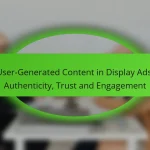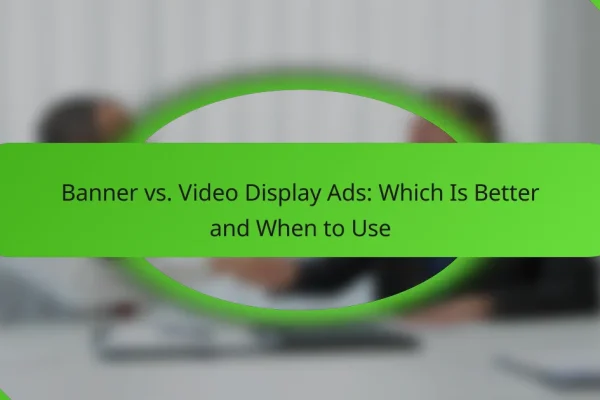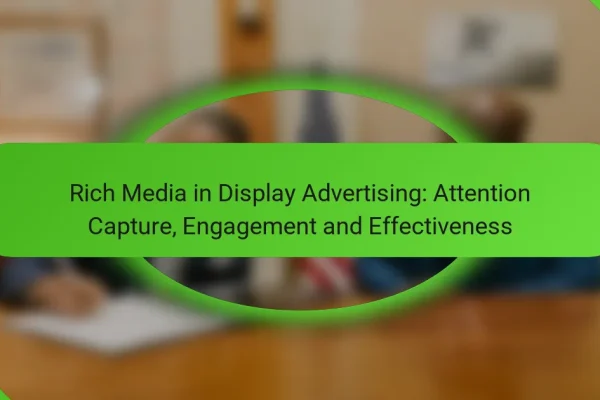What are the most effective display advertising creative formats?
The most effective display advertising creative formats include banner ads, video ads, rich media ads, native ads, and interstitial ads. Each format has unique characteristics and can be leveraged based on the campaign goals and target audience.
Banner ads
Banner ads are rectangular graphics displayed on web pages, typically at the top or sides. They are designed to attract attention and encourage clicks, often featuring a call to action. Standard sizes include 728×90 pixels for leaderboard banners and 300×250 pixels for medium rectangles.
When creating banner ads, focus on clear messaging and visually appealing designs. Avoid clutter and ensure that the call to action stands out. A/B testing different designs can help determine which performs best.
Video ads
Video ads are short clips that play before, during, or after online video content. They can range from a few seconds to a couple of minutes. Video ads are effective for storytelling and engaging viewers emotionally.
Consider using platforms like YouTube or social media channels for video ads. Keep the content concise and captivating, as viewers often skip ads quickly. Aim for a strong hook in the first few seconds to retain attention.
Rich media ads
Rich media ads incorporate interactive elements like animations, videos, or audio, enhancing user engagement. These ads can expand or change when a user interacts with them, providing a more immersive experience.
Utilize rich media formats to convey complex messages or showcase products effectively. However, ensure that they do not disrupt the user experience. Monitor performance metrics to assess engagement levels and adjust accordingly.
Native ads
Native ads blend seamlessly with the content of the platform they appear on, making them less intrusive. They often take the form of sponsored articles or posts that match the style and tone of the surrounding content.
To create effective native ads, focus on providing value and relevant information to the audience. Ensure that the ad is clearly labeled as sponsored to maintain transparency and comply with advertising regulations.
Interstitial ads
Interstitial ads are full-screen ads that appear at natural transition points in an app or website, such as between levels in a game or after a user clicks a link. They can be highly effective due to their visibility.
While interstitial ads can drive high engagement, use them sparingly to avoid frustrating users. Ensure that they are easy to close and do not disrupt the overall user experience. Testing different timings and placements can help optimize performance.
How do display advertising formats impact engagement?
Display advertising formats significantly influence user engagement by determining how effectively ads capture attention and drive interaction. Formats that resonate with audiences, such as video and interactive banners, tend to yield higher engagement rates compared to static ads.
Higher engagement with video ads
Video ads often lead to greater user engagement due to their dynamic nature and ability to convey messages more vividly. They can capture attention quickly and hold it longer, making them effective for storytelling and brand messaging.
Consider using video ads on platforms where users are accustomed to consuming video content, such as social media or streaming services. Aim for short, impactful videos, ideally under 30 seconds, to maintain viewer interest and encourage interaction.
Banner ads drive brand awareness
Banner ads are a staple in display advertising, primarily serving to enhance brand visibility. While they may not always lead to immediate clicks, they play a crucial role in reinforcing brand identity and recognition over time.
To maximize the effectiveness of banner ads, focus on eye-catching designs and clear calls to action. Positioning banners on relevant websites or platforms can also improve visibility and engagement, ensuring they reach the intended audience effectively.
What are the best practices for creating display ads?
Creating effective display ads involves a combination of clear messaging, strategic design, and continuous testing. Following best practices ensures that your ads capture attention and drive engagement.
Use clear calls-to-action
Clear calls-to-action (CTAs) are essential for guiding users on what to do next. Phrases like “Shop Now,” “Learn More,” or “Sign Up Today” should be prominently displayed and easy to understand. A strong CTA can significantly increase click-through rates.
Position your CTA where it stands out, such as in the center or bottom of the ad. Use contrasting colors to make it visually distinct from the background. Avoid vague language that may confuse potential customers.
Optimize for mobile devices
With a significant portion of web traffic coming from mobile devices, optimizing display ads for mobile is crucial. Ensure that your ads are responsive, meaning they adjust seamlessly to different screen sizes. This enhances user experience and increases the likelihood of engagement.
Keep text concise and images clear, as smaller screens can make details harder to see. Test your ads on various devices to ensure they load quickly and display correctly, aiming for load times under three seconds.
Test different formats
Experimenting with various ad formats can reveal what resonates best with your audience. Consider using static images, animated graphics, or video ads to see which format yields higher engagement rates. Each format has unique advantages that can appeal to different user preferences.
Utilize A/B testing to compare performance metrics such as click-through rates and conversion rates. This data-driven approach allows you to refine your advertising strategy and focus on the most effective formats for your target market.
What metrics should be tracked for display advertising success?
To measure display advertising success, focus on key metrics such as click-through rate (CTR), conversion rate, and return on ad spend (ROAS). These metrics provide insights into ad performance and help optimize campaigns for better results.
Click-through rate (CTR)
Click-through rate (CTR) indicates the percentage of viewers who click on an ad after seeing it. A higher CTR suggests that the ad is engaging and relevant to the audience. Generally, a CTR of 1-3% is considered average, while anything above 3% is often seen as strong.
To improve CTR, ensure that your ad copy is compelling and that the visuals are eye-catching. A/B testing different ad formats and messages can help identify what resonates best with your target audience.
Conversion rate
The conversion rate measures the percentage of users who complete a desired action after clicking on an ad, such as making a purchase or signing up for a newsletter. A typical conversion rate for display ads ranges from 1-5%, depending on the industry and ad quality.
To enhance conversion rates, optimize landing pages for user experience and ensure that the messaging aligns with the ad. Clear calls to action and minimal distractions can significantly boost conversion rates.
Return on ad spend (ROAS)
Return on ad spend (ROAS) evaluates the revenue generated for every dollar spent on advertising. A ROAS of 4:1, meaning $4 earned for every $1 spent, is often considered a good benchmark. However, acceptable ROAS can vary by industry and campaign goals.
To maximize ROAS, focus on targeting the right audience and refining ad placements. Regularly analyze performance data to adjust strategies and allocate budget effectively across high-performing ads.
What tools can help design display ads?
Several tools are available to help design effective display ads, each offering unique features and capabilities. Choosing the right one depends on your design skills, budget, and specific advertising needs.
Adobe Creative Cloud
Adobe Creative Cloud is a comprehensive suite of design tools that includes Photoshop, Illustrator, and InDesign, ideal for creating high-quality display ads. These applications allow for advanced editing, vector graphics, and layout design, making them suitable for professional designers.
While Adobe Creative Cloud offers powerful features, it comes with a subscription cost that may not be suitable for everyone. Users should consider their design experience and the complexity of their ads before committing to this platform.
Canva
Canva is a user-friendly design tool that caters to both beginners and experienced designers. It offers a wide range of templates and drag-and-drop functionality, making it easy to create visually appealing display ads without extensive design skills.
Canva operates on a freemium model, providing many features for free while offering premium options for a fee. This flexibility allows users to create ads quickly, but they should be mindful of the limitations of the free version, such as fewer template choices and design elements.
Google Web Designer
Google Web Designer is a free tool specifically designed for creating interactive HTML5 ads. It allows users to build responsive ads that can adapt to different screen sizes, making it a great choice for display advertising across various platforms.
This tool is particularly useful for those looking to incorporate animations and interactivity into their ads. However, users should be familiar with basic web design principles to maximize its potential and ensure their ads meet industry standards.











